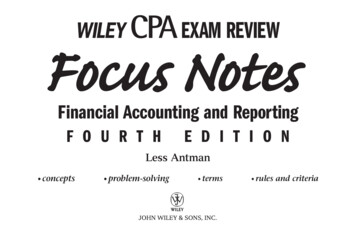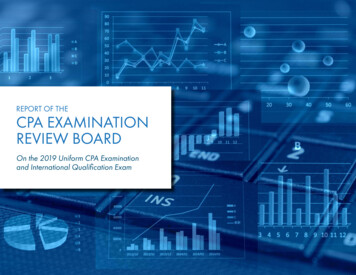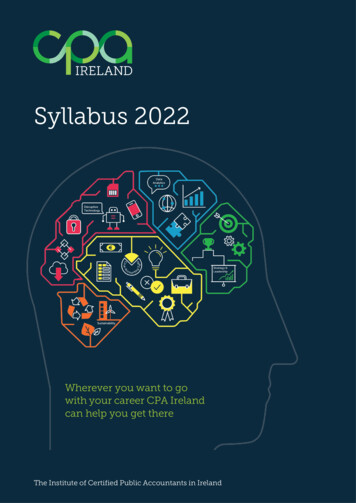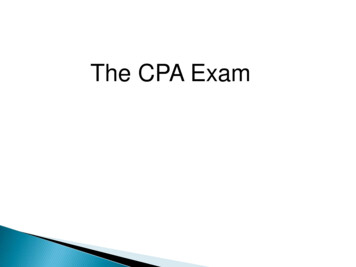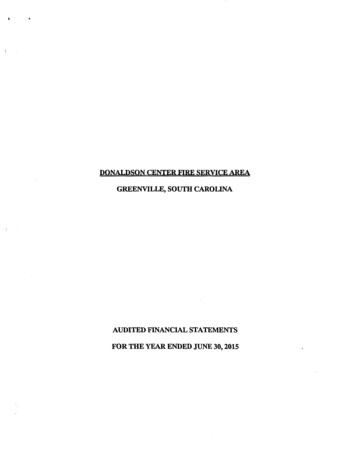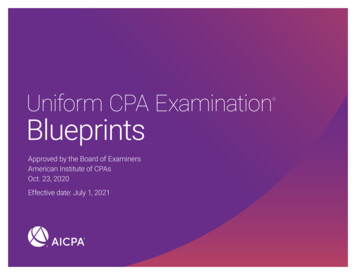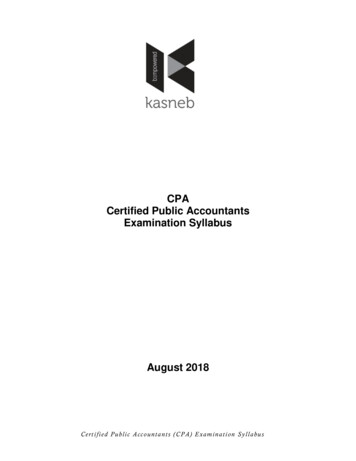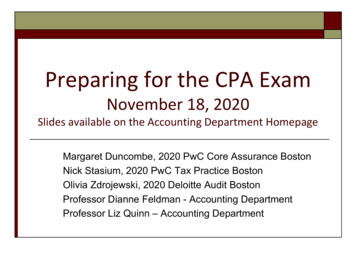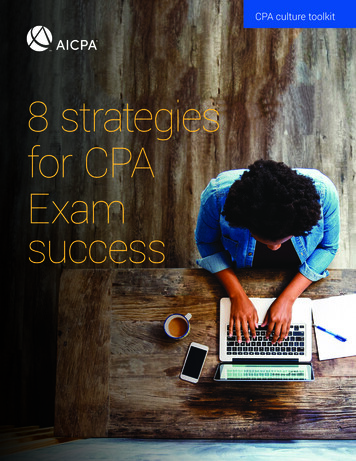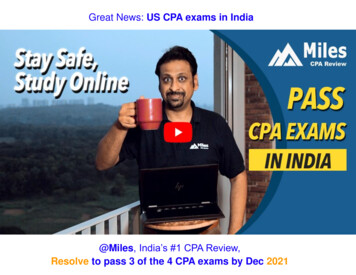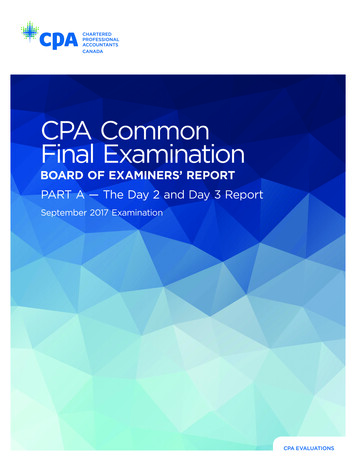
Transcription
CPA CommonFinal ExaminationBOARD OF EXAMINERS’ REPORTPART A — The Day 2 and Day 3 ReportSeptember 2017 ExaminationCPA EVALUATIONS
2018 Chartered Professional Accountants of CanadaAll rights reserved. This publication is protected by copyright and written permission isrequired to reproduce, store in a retrieval system or transmit in any form or by any means(electronic, mechanical, photocopying, recording, or otherwise).
BOARD OF EXAMINERS COMMITTEE MEMBERSChair: Terry Booth, FCPA, FCA, CFCollins Barrow Calgary LLPCalgary, AlbertaVice-Chair: Paul Van Bakel, CPA, CAMusashi Auto Parts Canada Inc.Waterloo, OntarioJoan Davison Conrod, FCPA, FCADalhousie UniversityHalifax, Nova ScotiaMonique Côté, CPA, CAMNP LLPCalgary, AlbertaSusan Deleau, FCPA, FCAThe Great-West Life Assurance CompanyWinnipeg, ManitobaMohamed Drira, MSc, PhD, CPA, CGAUniversity of New BrunswickFredericton, New BrunswickNaïma Hafidi, CPA, CGA, Msc FinancePublic Services and Procurement CanadaGatineau, QuébecRéal Jacques, CPA, CMA, M.Sc.HEC MontréalMontréal, QuébecGabriela Kegalj, CPA, CAKPMG LLPToronto, OntarioTanya Kirsch, CPA, CA, CFAUniversity of TorontoMississauga, OntarioDavid Legere, CPA, CABrantford, OntarioColin MacLean, FCPA, FCMADalhousie UniversityHalifax, Nova ScotiaPier-Olivier Migneault, CPA, CABusiness Development Bank of CanadaMontréal, QuébecDavid (Jordan) Oakley, CPA, CADeloitteWinnipeg, ManitobaJonathan Vandal, CPA, CA, Fin Pl.Groupe Lepore-GosselinMontréal, QuébecBill Waterman, CPA, CMAAurora CollegeYellowknife, North West TerritoriesMichael Wright, PhD, FCPA, FCGAUniversity of CalgaryCalgary, Alberta
TABLE OF CONTENTSPageThe Board of Examiners’ Report on the September 2017 Common Final Examination –Part A (Day 2 and Day 3) .1A Message to Candidates .8AppendicesAppendix A:Examination Design, Marking Guide Development, and Marking of theCommon Final Examination.20September 13, 2017 – Day 1 Simulations.25Day 1 – Version 1 FVT Case Linked to Capstone 1.26Day 1 – Version 2 PRI Case Linked to Capstone 1 .43September 14, 2017 – Day 2 Simulation and Marking Guides .55Day 2 – Simulation .56Marking Guide – Assurance Role (includes Common).94Marking Guide – Finance Role .130Marking Guide – Performance Management Role .150Marking Guide – Taxation Role .168September 15, 2017 – Day 3 Simulations and Marking Guides.189Day 3-1 Simulation .190Marking Guide 3-1.197Day 3-2 Simulation .216Marking Guide 3-2.221Day 3-3 Simulation .238Marking Guide 3-3.244Appendix E:Results by Assessment Opportunities for Day 2 and Day 3 .257Appendix F:Board of Examiners’ Comments on Day 2 and Day 3 Simulations .263CPA Regional and Provincial Contact Information.312Appendix B:Appendix C:Appendix D:See Part B for full Day 1 report on PRI simulations and marking guides.
The Board of Examiners’ Report on the2017 Common Final Examination – Part A (Day 2 and Day 3)Page 1THE BOARD OF EXAMINERS’ REPORT ON THECOMMON FINAL EXAMINATIONOBJECTIVES OF THE REPORTThe objective of this report is to explain the Common Final Examination (CFE) process and toassist the profession in improving the performance of candidates on the CFE.The report sets out the responsibilities of the Board of Examiners, the methods used for guidesetting and marking the CFE, and the results of the marking process. The report also includesrecommendations to candidates from the Board of Examiners.The September 2017 CFE Report is presented in two parts: Part A is the Day 2 and Day 3 Reportand Part B is the Day 1 report.The appendices provide more detailed information on the design, guide setting, and marking ofthe CFE, as well as the board’s expectations of candidates on the simulations. Readers arecautioned that the marking guides were developed for the entry-level candidate and that,therefore, all the complexities of a real-life situation may not be fully reflected in the content. TheCFE report is not an authoritative source of GAAP.RESPONSIBILITIES OF THE BOARD OF EXAMINERSThe Board of Examiners (BOE or the board) comprises a chair, a vice-chair, and sixteen membersappointed by the provincial bodies.The board’s responsibilities, as set out in its terms of reference, include the following:- Setting the CFE in accordance with the Chartered Professional Accountant Competency Map(the Map) and other directions from the Professional Education Management Committee;- Submitting the CFE and the marking guides to the provincial bodies for review;- Marking the candidates’ responses and recommending to the provincial bodies the pass or failstanding that should be given to each candidate; and- Reporting annually on the CFE to various CPA committees and the provincial bodies, in suchform and detail and at such time as is satisfactory to them.The chair is responsible for the supervision of the evaluation process. The entire board is activelyinvolved in the preparation of the CFE simulations, the preliminary marking guides, and the settingof the initial passing profile. A CFE subcommittee, made up of five members, participates in thePreliminary Evaluation Centre where the marking guides are tested against candidate responsesand finalized. The chair and vice-chair participate in the start-up of the marking centre and provideoversight throughout the marking process. The full board is responsible for determining thepassing standard.
The Board of Examiners’ Report on the2017 Common Final Examination – Part A (Day 2 and Day 3)Page 2THE CFEPreparation and Structure of the CFEThe board staff works in conjunction with authors to ensure that simulations achieve the overallintent and design objectives of the board while adhering to the competencies and the proficiencylevels specified in the Map.The full board provides guidance as to the content and nature of simulations to be included onthe examination. It also reviews and refines these simulations to make up the three-paperevaluation set.Nature of the SimulationsThe CFE comprises a set of simulations that are both essential and effective in evaluating thecandidates with regard to their readiness to be a CPA:Day 1 – The first paper is a four-hour examination consisting of a single simulation that is linkedto the Capstone 1 group case. There are two versions of the linked cases. Version 1 is linked tothe most current Capstone case, and is written by either first time writers, or by repeat writers whochose to attempt the new case rather than version 2 of the previous Capstone case. Version 2 iswritten by repeaters and candidates who deferred and are writing version 2 as their first attempt.Day 2 – The second paper is a five-hour case, with four different roles and requirements.Additional information tailored to each role is provided in four separate appendices.Day 3 – The third paper consists of three multi-competency area simulations.Assessment OpportunitiesThe board applies competency-based marking procedures that enable it to decide whichcandidates demonstrate readiness to enter the profession.Assessment Opportunities are designed to answer the question, “What would a competent CPAdo in these circumstances?” To attain a pass standing, candidates must address the issues in thesimulations that are considered significant.Appendix A contains a comprehensive description of the evaluation process.Marking GuidesMarking centre leaders and assistant leaders provide valuable input during the testing and settingof the marking guides, before live marking begins. The board chair, vice-chair, selected boardmember(s) and senior evaluations staff hold meetings with the leaders and their assistants duringboth the guide-setting and the marking processes. See Appendix B for the Day 1 simulationsthat appeared on the 2017 CFE and Appendix C and D for the Day 2 and Day 3 simulations and
The Board of Examiners’ Report on the2017 Common Final Examination – Part A (Day 2 and Day 3)Page 3marking guides. The marking results for Day 2 and Day 3, by Assessment Opportunity, appear inthe statistical reports found in Appendix E of this report. See Part B of the CFE Report for detailson Day 1, PRI version 1 and version 2.Day 1 – The marking guide is designed to assess the candidate on the stages of the CPA Way:1) situational analysis; 2) analysis of the major issues; 3) conclusions and advice; and 4)communication. Based on these four summative assessments, the candidate’s response is thenholistically judged to be either a passing or a failing response.Day 2 and Day 3 – Marking guides are prepared for each simulation. Besides identifying theAssessment Opportunities, each marking guide includes carefully defined levels of performanceto assist markers in evaluating a candidate’s competence relative to the expectations set out bythe board when developing the passing profile for a competent CPA.Five categories of performance are given for each Assessment Opportunity. The candidate’sperformance must be ranked in one of the five categories: Not AddressedNominal CompetenceReaching CompetenceCompetentCompetent with DistinctionSetting the Passing StandardThe board chair and vice-chair monitor live marking. Near the completion of the marking process,the CFE subcommittee satisfies itself that the markers applied the marking guides as intended bythe board.In determining which candidates pass the CFE, a passing profile is developed by the CFEsubcommittee of the board. A candidate is judged in relation to these pre-established expectationsof an entry-level chartered professional accountant. The passing profile decisions are ratified bythe full board. In setting the passing profile, the board considers the following:-The competency area requirements described in the MapThe level of difficulty of each simulationThe level of difficulty of each assessment opportunityThe design and application of the marking guidesComments from leaders and assistant leaders regarding any marking difficulties encounteredor any time constraints noted- Possible ambiguity of wording or of translation- Input on critical decision factors from an independent board of three CPAs who review the fairpass package
The Board of Examiners’ Report on the2017 Common Final Examination – Part A (Day 2 and Day 3)Page 4The Decision ModelThe purpose of the CFE is to assess whether candidates possess the competencies required ofan entry-level CPA through a written evaluation that is common to all CPAs. Each day of the CFEis unique and is designed specifically to assess different skills: Day 1 is linked to the Capstone 1 group case work. It assesses the candidates’ ability todemonstrate professional skills. It is independent from Day 2 and Day 3. Day 2 is the depth test. It assesses technical depth in one of four unique roles (that reflectthe four CPA elective choices) and provides depth opportunities in the common corecompetency areas of Financial Reporting and/or Management Accounting. Candidatespre-select one role and respond from that role’s perspective. Day 3 supplements the depth test in the common core areas of Financial Reporting and/orManagement Accounting. It is also the breadth test for all common core competencyareas.Candidates must pass all three days in order to qualify for entry to the profession. Those seekinglicensure must obtain depth in Financial Reporting and in the Assurance Role.Day 1Day 1 is assessed independently from Day 2 and Day 3. A pass or fail decision is made basedon a holistic assessment of the candidates’ performance in applying the CPA Way to demonstrateessential professional skills.Day 2 and Day 3The decision model used by the board is presented in Exhibit I. Four key decision points, or levels,are applied in reaching a pass or fail decision, as follows:1. The response must be sufficient; i.e., the candidate must demonstrate competence in theAssessment Opportunities presented on Day 2 and Day 3 (Level 1).2. The response must demonstrate depth in the common core area of Financial Accounting orManagement Accounting (Level 2).3. The response must demonstrate depth in the pre-selected elective role (Level 3).4. The response must demonstrate breadth across all competency areas of the Map, at a corelevel, by not having avoided a particular technical competency area (Level 4).
The Board of Examiners’ Report on the2017 Common Final Examination – Part A (Day 2 and Day 3)EXHIBIT IDAY 2 AND 3 PASS/FAIL ASSESSMENT MODELPage 5
The Board of Examiners’ Report on the2017 Common Final Examination – Part A (Day 2 and Day 3)Page 6Approving the ResultsThe CFE subcommittee reviews and approves the marking results for each simulation. Day 1 isassessed separately from Day 2 and Day 3.Day 1 – The CFE subcommittee discusses the profiles for both the marginally passing andmarginally failing candidates to confirm that the board’s pre-established passing profile has beenappropriately applied by the markers.Day 2 and Day 3 – As part of the development process, the CFE subcommittee sets preliminaryrequirements for the three levels (tests of depth and breadth) being assessed on the Day 2 andDay 3 simulations. After the marking is completed, the board reviews and finalizes thoserequirements. The board establishes the Level 1 (sufficiency) requirement for the combined Day 2and Day 3 simulations.During the approval process, the board continues to consider whether the results could beaffected by any inconsistency in the evaluation or the board’s processes.ReportingIn reaching its decision, the board determines which candidates pass on a national basis only,without regard to provincial origin or language. Similarly, the detailed comments are based onanalyses of the performance of all candidates.The board reports the following information by candidate number:- Overall pass/fail standing and pass/fail standing for each of Day 1 and of Day 2 and Day 3combined.- A pass/fail standing for Day 1.- A pass/fail standing for Level 1, Sufficiency.- A pass/fail standing for Level 2, Depth in Financial Reporting and/or Management Accounting.- A pass/fail standing for Level 3, Depth in Role.- A pass/fail standing for Level 4, Breadth in all technical competency areas.
The Board of Examiners’ Report on the2017 Common Final Examination – Part A (Day 2 and Day 3)Page 7Thank YouAll board members wish to express their warm and sincere appreciation for the outstandingenergy, support, and commitment of the small group of Board of Examiners staff members whosededication and talent contributed in large measure to the achievement of our objectives and thefulfilment of our responsibilities.We also wish to acknowledge the contributions made by the provincial reviewers, markers,authors, translators, and editors. The commitment, energy, and skill demonstrated by all themarkers were outstanding, resulting in the sound application of marking procedures andproducing an appropriate evaluation of the candidates. Everyone’s commitment to the quality andfairness of the process is appreciated.Terry Booth, FCPA, FCA, CFChairBoard of Examiners
A Message to CandidatesPage 8A MESSAGE TO CANDIDATESTo attain a pass standing, candidates needed to achieve a “Pass” on Day 1 and, on Day 2and Day 3 combined, to demonstrate sufficient competence in all areas plus meet the twodepth standards and the breadth standards.INTRODUCTIONThe September 2017 CFE Report presents detailed information on candidates’ performance forall the examination cases, except for FVT, the Day 1 linked case, Version 1. Commentary on theperformance of candidates on Day 1 (FVT Version 1) is provided in a summary format only in thismessage to candidates, since detailed commentary on FVT will only be provided after Version 2is written in September 2018. The simulations, marking guides, marking results, and Board ofExaminers’ comments on Day 2 and 3 of the examination are found in this document (Part A ofthe CFE Report). Similar information on Day 1 (PRI version 1 and version 2) can be found inPart B of the CFE Report.The intent of this message is to highlight common areas of deficiency and to offer advice from theBOE to help candidates understand how to improve their performance on the CFE.Nature of the CFEThe design of the CFE is such that each day of the examination allows candidates to demonstratea different skill set. Day 1 allows candidates to demonstrate their high-level professional skills,such as critical analysis, decision-making, and professional judgment, as well as communication.Day 2 allows candidates to demonstrate their technical competence in the common FinancialReporting and, or Management Accounting competencies and in their chosen role, which ties toone of the four elective areas. Day 2 clearly directs candidates to the work to be done and is notdesigned to be time-constrained, allowing candidates to demonstrate depth. Day 3 allowscandidates to demonstrate depth in the common Financial Reporting and ManagementAccounting competencies and provides multiple opportunities to demonstrate breadth in all thecore technical competency areas. Day 3 is less directive and more integrative than Day 2. It isalso time-constrained, requiring candidates to prioritize their time per issue.Specific Strengths and WeaknessesEnabling – Professional SkepticismFor the first time this year, there was a common enabling AO on Day 2 (AO#7). Information wasprovided throughout the case that should have led candidates to question some of the actions ofFRE’s COO, Andy. Candidates were told that Andy maintains an active role on Halloran’s boardof directors, a company FRE has used for building several of its buildings. They were also toldthat a foundation crack in a property built by Halloran had resulted in FRE selling the property ata significant loss a few years ago. In addition, a large crack was recently found in the foundationof another building constructed by Halloran. Andy directed the VP Acquisitions, Construction &Maintenance not to investigate the crack. Candidates were expected to put together these casefacts and explain the potential conflict of interest in Andy’s different roles and the fact that he maynot be acting in the best interests of FRE. While candidates were not explicitly directed to thisassessment opportunity, the Board would have liked to see more candidates raise this issue.
A Message to CandidatesPage 9The Board acknowledges that, because the issue was non-directed and required candidates tointegrate case facts spread throughout Day 2, the issue was not easy. However, an important skillexpected of a CPA is professional skepticism and being aware when information indicates thatthere may be an underlying problem. Therefore, despite the lack of direction, candidates shouldhave recognized that Andy’s behaviour was questionable and that it was their duty as a CPA tobring this issue to Gloria’s attention.CommunicationA majority of candidates communicated clearly and professionally. For the most part, candidates’responses were well organized, with a logical flow. However, the BOE still found that someresponses were unclear, often due to the use of extreme point-form, which sometimes made itdifficult to interpret the meaning and intention of what candidates had written. The BOE also notedthere were candidates who merely repeated the case facts, with no further explanation as to whyeach fact was listed. This was typically done in point form. For example, on Day 2, Assurancerole, candidates provided examples of case facts that affected the overall financial statement riskbut did not explain why each fact increased or decreased the risk assessment. On Day 2,Performance Management role, many candidates listed case facts as either pros or cons withoutany further explanation. In addition, when discussing the board governance, candidates restatedcase facts but often did not explain whether each was a strength or weakness and why. On Day2, Finance role, many candidates listed case facts as either a pro or con when analyzing thequalitative aspects of the townhouse project, without explaining why. On Day 3, Simulation 2, theBoard saw a similar approach taken to the discussion of the e-book format versus the printedbook. Some candidates simply listed case facts under either “pro” or “con” for each format, withno further explanation as to why each factor would be either an advantage or disadvantage ofeach option. Similarly, on Day 3, Simulation 3, some candidates listed case facts under eachSWOT category without any further explanation.Most candidates’ quantitative analyses were well organized, with a logical flow. However, as wasmentioned for the prior examinations, some candidates still did not explain the details of theircalculations, making it hard to know what assumptions they used or how they arrived at theirfigures. For example, on Day 3, Simulation 2, candidates did not always explain why they weremaking normalizing adjustments to the earnings. Candidates’ calculations were also lacking onDay 3, Simulation 1, where candidates provided a conclusion on whether or not the criteria forthe grant claw-back were met without providing supporting calculations. Without seeing theunderlying calculation, it was difficult to determine if the reasoning behind the comment made wasvalid.Candidates are reminded that they need to clearly explain their train of thought to demonstratecompetence. It is not sufficient to just state a correct conclusion. The Board is interested inunderstanding a candidate’s logic and wants to see evidence of the analysis and professionaljudgment that has been applied.
A Message to CandidatesPage 10Time ManagementAn improvement in time management was noted on the September 2017 CFE, in particular withregards to Day 3. With a few exceptions described in this section, time was also well managedon the Day 1 and Day 2 simulations, which are not designed to be time-constrained.Although neither of the Day 1 simulations on the September 2017 CFE were time-constrained intheir design, some time management issues were still evident. Some candidates spent aninordinate amount of time preparing a full situational analysis, rather than simply addressing thechanges that were relevant based on the case facts presented. Others spent too much timeanalyzing one of the issues presented, to the detriment of the others.Some candidates in the Day 2 Taxation and the Day 2 Finance role spent too much time on thecommon management accounting AOs. In addition, a number of candidates chose to leave themore difficult taxation or finance requireds to the end. While candidates are free to address therequireds in the order they like, by focusing on easier issues or by spending too much time on thequantitative calculations, candidates run the risk of running out of time to address all of therequireds, as was seen frequently on both of these Day 2 roles.Candidates are reminded that spending too much time on any one required can hurt performanceon another required. Allocating sufficient time to cover all of the requireds, while still ranking theimportance of the issues, is essential. Judgment is required in determining how much evidenceto provide to demonstrate competence per AO. The BOE is looking for sufficient, but notexcessive, depth to be demonstrated. Day 2 in particular is designed to allow time for filteringinformation and planning the response. Candidates are encouraged to use the time provided toplan sufficient time to address all the requireds.The Board saw a marked improvement in candidates’ time management on Day 3. There wasmuch less evidence of candidates going over the suggested times on Simulation 1 and sometimesSimulation 2, to the detriment of their performance on Simulation 3. The Board was pleased tosee candidates generally following the suggested times for each simulation on Day 3 to ensurethey had the opportunity to answer all the requireds.Despite an improvement from the prior year, there was still some evidence on Day 2 and Day 3of candidates skipping issues (see the percentage of Not Addressed). For example, on Day 2, agreater number of candidates did not attempt to discuss the impairment issue at all. On Day 2,Finance role, some candidates skipped the most difficult required (AO#11 – tenant financing).Also, a greater number of candidates did not attempt AO#13 (Bates offer). This was not a difficultAO. It may be that candidates did not address the issue due to the time management issuesdiscussed earlier. On Day 3, Simulation 1, a greater number of candidates did not address theclawback, procedures, and performance measures. Also, on Day 3, Simulation 3, morecandidates avoided the responsibility centres and transfer pricing issue. All of these issues weredirected to, but they were ones that candidates struggled with.
A Message to CandidatesPage 11The Board is concerned that candidates may be intentionally not addressing the difficult issues infavour of the easier ones. The BOE reminds candidates that the CFE has not only depth andbreadth tests, but also a sufficiency score. Skipping issues affects the sufficiency score.Candidates are encouraged to attempt all the requireds, managing their time carefully in doingso.Day 1Points have been excerpted from the September 2016 Board of Examiners’ report on Day 1,Version 1 of PRI. Additional commentary based on candidates’ performance on Version 2has been added.Comments Specific to Day 1 (PRI Version 1) [excerpted from September 2016 CFE Report]The following paragraphs elaborate on the strengths noted and draw attention to the commonweaknesses identified by the Board of Examiners on the September 2016 CFE, Day 1, Version 1of PRI.The PRI Day 1, Version 1 case presented less opportunity for financial assessments andcalculations than previous cases (CHEI and RSI). It had more undirected issues, and candidatesneeded to be careful not to lose sight of the need to address not only the operational matters butalso the high-level qualitative strategic analysis that was required for each major issue.Candidates struggled to identify the issue they were not directed to (governance and bonus).Candidates are reminded to step back and consider the broader problems, rather than taking anissue-by-issue, silo approach. It is important to integrate the case facts, particularly thoseimportant factors highlighted in the situational analysis, to identify the broader strategic issues.Generally, candidates presented their responses in a well-structured format, beginning with thesituational analysis and followed by an analysis of the issues they identified and a conclusion.The level of communication was generally good, with few exceptions.All candidates started with a situational analysis. However, many simply restated case factswithout putting those facts together to consider the implications to the situation presented. TheBOE noted that many candidates appeared to go through a “checklist” that looked like a templateapproach, rather than logically addressing the matters that were relevant to the case beingspecifically presented. Candidates are reminded to think through the issues. There is no pointpresenting a situational analysis that is several pages long if that information is not going to beused as part of the analysis of the issues. Instead, the situational analysis should focus on theelements that have changed since Capstone 1 or those that will affect the decisions. These factscan then be linked to the later analysis.
A Message to CandidatesPage 12Comments Specific to Day 1 (PRI Version 2)Similar to Version 1, most candidates performed an appropriate situational analysis, identifyingthe important factors that had changed from the Capstone case or were new and relevant to PRI.Where many candidates fell short was in their failure to link their assessment of the situation withintheir analysis of the issues. For example, many candidates highlighted the mission and visionstatements and PRI’s values, but then failed to bring those elements into the discussion of whichsystem is the better fit for PRI.A number of candidates simply recapped the case facts, typically in extremely short bullet points,with no explanation as to why they were important enough to be listed. For example, candidateswould simply state a case fact like, “Jeff wants to expand into the U.S.,” but would not discuss therelevance of the point or use it in their analysis. As another example, candidates would identifythe disagreement between Jeff and George in terms of future strategies but would not use thatinformation in their analysis. This approach was not considered sufficient for a situational analysis.At the other end of the spectrum were those candidates who went into too much depth in theirsituational analysis, redoing the entire analysis rather than focusing on the changes, which thecase specifically directed them to do.There were three major issues that candidates were expected to analyze from both an operationaland a strategic perspective: the choi
The Board of Examiners Report on the September 2017 Common Final Examination Part A \(Day 2 and Day 3\) 1 . A Message to Candidates 8 . Appendix A: Examination Design, Marking Guide Development, and Marking of the Common Final Examination20 . Appendix B: September 13, 2017 Day 1 Simulations25 . Day 1 Version 1 FVT Case Linked to Capstone 126
